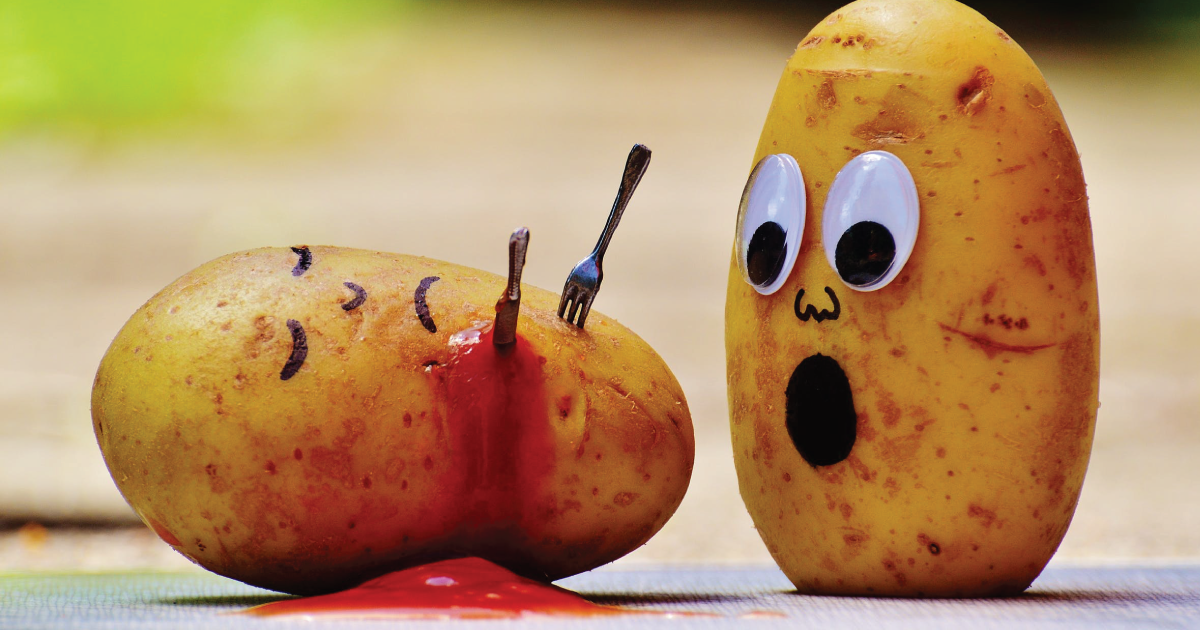
Beware of GMO Potatoes
The Innate® potato has been modified using RNA interference (RNAi) technology to inhibit blackspot bruising and browning by reducing levels of asparagine and certain enzymes in the potato. In addition to white russet potatoes, ranger russet, russet Burbank and Atlantic potatoes have also been modified in this way.
November 27, 2018 | Source: Mercola.com | by Dr. Joseph Mercola
Any product made with potato will henceforth be subject to added scrutiny before it can receive The Non-GMO Project’s verification stamp.1 The reason? The now widespread prevalence of genetically engineered (GE) potato in the U.S. food supply.
The first-generation GE Innate® potato, developed by J.R. Simplot Co. and branded simply as White Russet™, was approved by the U.S. Department of Agriculture (USDA) in 2014 and entered the U.S. marketplace the following year.2 Canada approved it in 2016.3
The Innate® potato has been modified using RNA interference (RNAi) technology to inhibit blackspot bruising and browning by reducing levels of asparagine and certain enzymes in the potato. In addition to white russet potatoes, ranger russet, russet Burbank and Atlantic potatoes have also been modified in this way.
The Non-GMO Project has also announced4 the marketing of a new high-oleic acid GE soy variety, engineered with TALEN gene editing technology. It too has been added to the Project’s high-risk list and is ineligible for The Non-GMO Project Verification label. According to Megan Westgate, executive director of The Non-GMO Project:5
“The supply chain risks we’re now seeing from new GMOs are unprecedented in the decade we’ve been verifying products. Not only are new GE techniques being used, but in some cases biotechnology companies are using unscientific arguments to deceive the public into thinking their products are non-GMO.”
GMO Potatoes Hide Spoilage
J.R. Simplot claims the nonbrowning potatoes benefit consumers, farmers and the environment by cutting down on food spoilage waste and reducing water use and greenhouse gas emissions.6Trials have shown the Innate® potatoes result in farmers discarding 15 percent fewer potatoes due to bruising and spotting.7
“Another great advantage of Innate® potatoes is that they can be cut, peeled or diced in advance. With Innate’s reduced browning benefits, potatoes can be prepared ahead of time, and stay fresher-looking longer.
In addition to reducing waste, nonbrowning potatoes give foodservice operators and restaurants options for labor savings and off-site peeling or dicing,” Simplot’s website states.
However, as noted by Westgate,” browning is nature’s most visible way of letting you know a product is rotting. GMOs that use RNAi to mask the signs of bruising could lead consumers to unknowingly ingest an unhealthy, toxic product.”
According to Simplot, however, by reducing asparagine, which creates acrylamide, a probable carcinogen, at high temperatures, the Innate® potatoes lower the potential health hazards associated with baked, fried and roasted potatoes.8
Second generation Innate® potatoes are currently under regulatory review. In addition to being nonbrowning, these second generation crops are also engineered to be blight resistant. According to a February 28, 2017, press release:9
“[T]he United States Environmental Protection Agency (EPA) and Food and Drug Administration (FDA) have completed their independent reviews and granted registrations and clearances for three varieties of Simplot’s second generation of INNATE® potatoes.
The three varieties have already been deregulated by the USDA so these new agency registrations and clearances permit these proprietary bioengineered potatoes to be grown and sold in the United States.
The INNATE® Gen. 2 Russet Burbank, Ranger Russet and Atlantic varieties contain significant benefits to growers, processors and consumers with reduced bruising and black spots; reduction of the natural chemical compound asparagine; protection from late blight pathogens; and enhanced cold storage capability.”
Creator of GMO Potatoes Reveals Danger
How can we know Innate® potatoes are a health risk? Because their creator, a genetic engineer named Caius Rommens, former director of researcher and development for the potato program at J.R. Simplot Co. and a former team leader at Monsanto, wrote an entire book about it.
In “Pandora’s Potatoes: The Worst GMOs,”10 released October 7, 2018, Rommens reveals these and similar GE potatoes contain “unstable traits, two of which appear to have been lost already (or are in the process of being lost).”
He also claims the GE potatoes “suffer a significant yield drag and reduction in size profile, conceal bruises and potentially spread diseases, may be grown and stored in ways that maximize disease and pest pressures … [and] are also likely to contain new toxins. If it were up to me, the creator of these potatoes, I would call them Pandora’s Potatoes. They are the worst GMOs ever commercialized.” Rommens also discusses his concerns in an interview with Sustainable Pulse, in which he says:11
“I had my potatoes tested in greenhouses or the field, but I rarely left the laboratory to visit the farms or experimental stations. Indeed, I believed that my theoretical knowledge about potatoes was sufficient to improve potatoes. This was one of my biggest mistakes …
It is amazing that the USDA and FDA approved the GM potatoes by only evaluating our own data. How can the regulatory agencies assume there is no bias? When I was at J.R. Simplot, I truly believed that my GM potatoes were perfect … I was biased and all genetic engineers are biased …
We test our GM crops to confirm their safety, not to question their safety. The regulatory petitions for deregulation are full with meaningless data but hardly include any attempts to reveal the unintended effects.
For instance, the petitions describe the insertion site of the transgene, but they don’t mention the numerous random mutations that occurred during the tissue culture manipulations.
And the petitions provide data on compounds that are safe and don’t matter, such as the regular amino acids and sugars, but hardly give any measurements on the levels of potential toxins or allergens.”
